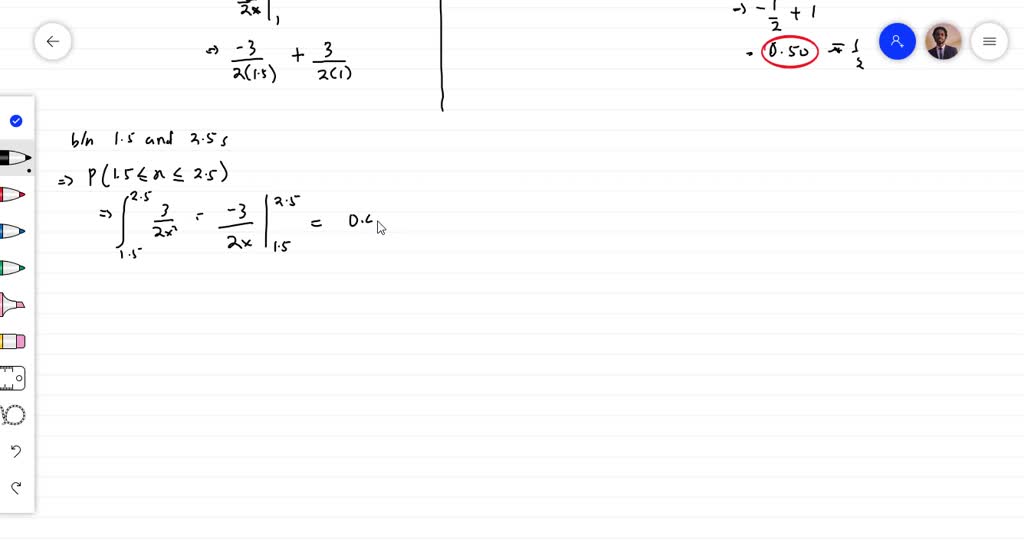The Reaction Time in Seconds to a Stimulus is a Continuous Random Variable With Pdf

The reaction time (in seconds) for a certain stimulus is a continuous random variable with pdf 3/2 Ix2 for_1x<3 f(x) elsewhere Plot the PDF and CDF between the values of Sx< 3 b. Compute the mean expected reaction time Compute the standard deviation of reaction time d. Find the 60th percentile reaction time What is the probability the reaction time is between 1.5 and 2.5 seconds?

Related Question
The reaction time in seconds to a certain stimulus is a continuous random variable with pdf 1 <x < 3 otherwise f(x) = Part 2x2 What is the probability that reaction time is at most 1.5 sec? At least 1.5 sec? Between 1.5 and 2.5 sec? What is the mean and standard deviation of the reaction time?
Discussion
You must be signed in to discuss.
Video Transcript
for this problem we have a probability density function F of X is equal to three divided by two X squared and it exists within the range 123. Now we define a random variable X as the reaction time in seconds. These are a list of formulas will be using for this problem. So for the first question we have to determine the probability that the reaction time is at most 1.5 seconds. So we can write that as the probability that X is less than or equal to 1.5. This is equal to the integral from 1 to 1.5 of the function of F of X. That is stay divided by two X squared dx. So we compute the integral and that is equal to negative three over two X as we integrate from 1 to 1.5. So we substitute the values of 1.5 and one place of X. We have negative theory divided by two times 1.5 minus. And we have negative theory. So that makes this positive divided by two times one. Therefore we have negative three divided by two times 1.5. That is equal to three plus, very divided by two and this is equal to negative one. So we have negative one plus 3/2. And this is equal to 1/2 or 0.50 for the next question we have to determine the probability that the reaction time is at least 1.5 second. That is because in the probability that X. S splitter down or equal to 1.5 it just becomes the integral from 1.52. Three of the function three divided by two X grade dx. And the integral is equal to negative three divided by two X. And from here we integrate from 1.5 to 3. Before this becomes negative three divided by two times three minus. Now we have a negative here again. So this becomes plus. They were divided by two times 1.5. So this is equal to negative three divided by 3 to 6 plus. Very divided by three. And this is equal to negative 1/2 last one and not difficult to 0.5. Yeah or one house. Then for the next question we have to determine the probability that the reaction time is between 1.5 and 2.5 seconds between 1.5 and 2.5 seconds. So that combination as the probability that 1.5 is less than or equal to x. Other celebs than or equal to 2.5. Therefore we have the integral from 1.5 to 2.5. The function three divided by two X squared. And this user is negative three divided by two X. As to integrate form 1.5 to 2.5. And computing this gives us 0.40. Then on to the next set of questions we have to determine the mean and standard education. So the formula for the meal as we integrate from it to be A and B represents the lower and upper limits of the function X times F of X dx. Oh therefore the mean is equal to check out from A to B X times F of X. Yes, so this becomes the integral from 1 to 3 X times three divided by two X squared. Yeah, so X can council one of the X and we are left with three divided by two X lex. And when we integrate this function we have 3/2. Sometimes they're not trying to guard him effects as we integrate from 1 to 3. Mhm Should I become stereo over to times? Natural law Guardian of three. Mine is the natural algorithm of one. The natural log of three is equal to 1.0 986. And then they're not sure that is simply zero. So you have three divided by two times 1.96. Now that's equal to 1.6 for A. And then for the next question we have to find the standard deviation to find a standard deviation. You need to first of all find the variance that is equal to the integral form 123. We have X squared times F of X and F of X is given us three divided by two X squared the X and this whole expression minus the square of the meat. Mhm two, you have the integral from 1 to 3 X square divided by X squared. To go to one, there's simply half three or about to the x minus the square. They mean that is 1.648 squared. When you integrate this whole expression we have there were over two X. I was going to go from 1 to 3. No we have through over two times three minus stereo over to times one. This is equal to 9/2 minus 3/2. So we have six over to that is equal to three R corresponds to this expression, so we still have three minus 1.648 squared not is equal to 0.2 84. So this figure represents the variance. And then to compute the standard deviation. Standard deviation is simply the square root of the variance. That is equal to the square root of 0.284 is equal to 0.5 33.
Source: https://www.numerade.com/ask/question/the-reaction-time-in-seconds-for-a-certain-stimulus-is-a-continuous-random-variable-with-pdf-32-ix2-for_1x3-fx-elsewhere-plot-the-pdf-and-cdf-between-the-values-of-sx-3-b-compute-the-mean-ex-62603/

Post a Comment for "The Reaction Time in Seconds to a Stimulus is a Continuous Random Variable With Pdf"